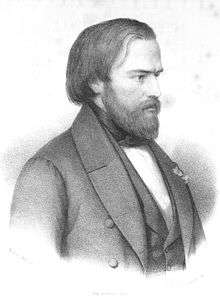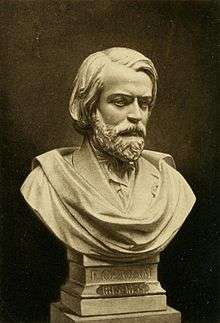Frédéric Ozanam
| Blessed Antoine-Frédéric Ozanam | |
|---|---|
| Born |
April 23, 1813 Milan, Kingdom of Italy |
| Died |
September 8, 1853 (aged 40) Marseilles, France |
| Venerated in | Catholic Church |
| Beatified | August 22, 1997, Cathedral of Notre Dame de Paris by Pope John Paul II |
| Feast | September 09 |
Antoine-Frédéric Ozanam (pronounced: [ɑ̃.twan.fʁe.de.ʁik o.za.nam]; April 23, 1813 – September 8, 1853) was a French literary scholar, lawyer, journalist and social justice advocate. He founded with fellow students the Conference of Charity, later known as the Society of Saint Vincent de Paul.[1] He was beatified by Pope John Paul II in the Cathedral of Notre Dame de Paris in 1997, hence he may be properly called Blessed Frederic by Catholics. His feast day is September 9.
Life
Frédéric was born on April 23, 1813, to Jean and Marie Ozanam.[2] He was the fifth of Jean and Marie Ozanam’s 14 children, one of only three to reach adulthood.[3] His family, which believed itself to have Jewish blood, had been settled in the region around Lyon, France, for many centuries. An ancestor of Frédéric, Jacques Ozanam (1640–1717), was a noted mathematician. Jean Ozanam, Frédéric's father, had served in the armies of the First French Republic, but with the rise to power of Napoleon Bonaparte, and the founding of the First French Empire, he turned to trade, to teaching, and finally to medicine.
Frédéric was born in Milan, but brought up in Lyon. In his youth he experienced a period of doubt regarding the Catholic faith, during which he was strongly influenced by one of his teachers at the Collège de Lyon, the priest Abbé Noirot. His conservative and religious instincts showed themselves early, and he published Réflexions sur la Doctrine de Saint-Simon a pamphlet against Saint-Simonianism in 1831,[4] which attracted the attention of the French poet and politician Alphonse de Lamartine, born in the area. Ozanam also found time to help organize and write for the Association for the Propagation of the Faith, a lay Catholic organization founded in the city with the aim of supporting Catholic missionaries, of which many came from the area. That autumn he went to study law in Paris, where he suffered a great deal from homesickness. Ozanam fell in with the Ampère family (living for a time with the mathematician André-Marie Ampère), and through them with other prominent Catholics of the time, such as Count François-René de Chateaubriand, Jean-Baptiste Henri Lacordaire, and Charles Forbes René de Montalembert.
While still a student, Frédéric took up journalism and contributed considerably to Bailly's Tribune catholique, which became L'Univers, a French Catholic daily newspaper that adopted a strongly ultramontane position. Ozanam and his friends revived a discussion group called a "Society of Good Studies" and formed it into a "Conference of History" which quickly became a forum for large and lively discussions among students. Their attentions turned frequently to the social teachings of the Gospel. At one meeting during a heated debate in which Ozanam and his friends were trying to prove from historical evidence alone the truth of the Catholic Church as the one founded by Christ, their adversaries declared that, though at one time the Church was a source of good, it no longer was. One voice issued the challenge, "What is your church doing now? What is she doing for the poor of Paris? Show us your works and we will believe you!"[5]
As a consequence, in May 1833 Frédéric and a group of other young men founded the charitable Society of Saint Vincent de Paul,[4] which already by the time of his death numbered upwards of 2,000 members. The founding members developed their method of service under the guidance of a Sister (now Blessed) Rosalie Rendu, a member of the Congregation of Daughters of Charity of Saint Vincent de Paul, who was prominent in serving the poor in the slums of Paris. The members of the conferences collaborated with Sister Rosalie during the time of the cholera epidemic. When fear had gripped the population, she organized the conferences in all the neighborhoods of Paris to care for the cholera victims, becoming well known in the city for her work, especially in the 12th arrondissement.[6] Frederic's first act of charity was to take his supply of winter firewood and bring it to a widow whose husband had died of cholera.

Ozanam received the degrees of Bachelor of Laws in 1834, Bachelor of Arts in 1835 and Doctor of Laws in 1836. His father, who had wanted him to study law, died on May 12, 1837. Although he preferred literature, Frédéric worked in the legal profession in order to support his mother, and was admitted to the Bar in Lyon in 1837.[6] Still, he also pursued his personal interest, and in 1839 he obtained the degree of Doctor of Letters with a thesis on Dante that then formed the basis of Ozanam's best-known books. A year later he was appointed to a professorship of commercial law at Lyon, and in 1840, at the age of twenty-seven, assistant professor of foreign literature at the Sorbonne.[4] He decided to give a course of lectures on German Literature in the Middle Ages and in preparation for it went on a short tour of Germany. His lectures proved highly successful despite the fact that he attached fundamental importance to Christianity as the primary factor in the growth of European civilization, unlike his predecessors and most of his colleagues, who shared in the predominantly anti-Christian climate of the Sorbonne at that time.[7]
In June 1841, he married Amélie Soulacroix, daughter of the rector of the University of Lyon,[8] and the couple travelled to Italy for their honeymoon. They had a daughter, Marie.
Candelas describes Ozanam as " ... a man of great faith. He valued friendships and defended his friends no matter what the cost. He was attentive to details, perhaps to the extreme. ... [H]e showed a great tenderness when dealing with his family. ...He had a great reverence for his parents, and revealed his ability to sacrifice his career and his profession in order to please them.[6]
Upon the death in 1844 of Claude Charles Fauriel, Ozanam succeeded to the full professorship of foreign literature at the Sorbonne.[4] The remainder of his short life was extremely busy, attending to his duties as a professor, his extensive literary activities, and the work of district-visiting as a member of the society of St Vincent de Paul.
During the French Revolution of 1848, of which he took a sanguine view, he once more turned journalist by writing, for a short time, in various papers, including the Ère nouvelle ("New Era"), which he had founded. He traveled extensively, and visited England at the time of the Exhibition of 1851.
Death
His naturally weak constitution, however, fell a prey to consumption, which he hoped to cure by visiting Italy, but on his return to France, he died in Marseille on September 8, 1853 at the age of forty. He was buried in the crypt of the church of St. Joseph des Carmes at the Institut Catholique in Paris.[4]
Works

Ozanam was the leading historical and literary critic in the neo-Catholic movement in France during the first half of the 19th century. He was more learned, more sincere, and more logical than Chateaubriand; and less of a political partisan and less of a literary sentimentalist than Montalembert. In contemporary movements, he was an earnest and conscientious advocate of Catholic democracy and of the view that the Church should adapt itself to the changed political conditions consequent to the French Revolution.[9]
In his writings he dwelt upon important contributions of historical Christianity, and maintained especially that, in continuing the work of the Caesars, the Catholic Church had been the most potent factor in civilizing the invading barbarians and in organizing the life of the Middle Ages. He confessed that his object was to prove the contrary thesis to Edward Gibbon, and, although the aim of proving theses is perhaps not the ideal approach for a historian, Ozanam no doubt administered a healthful antidote to the prevalent notion, particularly amongst English-speaking peoples, that the Catholic Church had done far more to enslave than to elevate the human mind. His knowledge of medieval literature and his appreciative sympathy with medieval life admirably qualified him for his work, and his scholarly attainments are still highly esteemed.
His works were published in eleven volumes (Paris, 1862–1865). They include:
- Deux chanceliers d'Angleterre, Bacon de Verulam et Saint Thomas de Cantorbéry (Paris, 1836)
- Dante et la philosophie catholique au XIIIeme siècle (Paris, 1839; 2nd ed., enlarged 1845)[10]
- Études germaniques (2 vols., Paris, 1847–1849), translated by A. C. Glyn as History of Civilization in the Fifth Century (London, 1868)
- Documents Inédits pour servir a l'histoire de l'Italie depuis le VIIIeme siècle jusqu'au XIIeme (Paris, 1850)
- Les Poètes franciscains en Italie au XIIIme siècle (Paris, 1852)
- His letters were partly translated into English by A. Coates (London, 1886).
References
- ↑ Brodrick, James (1933). Frederic Ozanam and His Society. London: Burns, Oats & Washbourne, Ltd.
- ↑ Derum, James P. (1960). Apostle in a Top Hat; the Life of Frédéric Ozanam. Garden City, N.Y.: Hanover House.
- ↑ Foley O.F.M., Leonard. "Blessed Frédéric Ozanam", Saint of the Day, Lives, Lessons and Feast, (revised by Pat McCloskey O.F.M.), Franciscan Media
- 1 2 3 4 5 Bertrin, Georges. "Antoine-Frédéric Ozanam." The Catholic Encyclopedia. Vol. 11. New York: Robert Appleton Company, 1911. 17 Sept. 2014
- ↑ "Blessed Frederic Ozanam", St. Vincent de Paul Society, Australia
- 1 2 3 Candelas D.C., M. Teresa. "Biography of Frederic Ozanam", Vincentian Encyclopedia
- ↑ "Frédéric Ozanam", Vincentian Encyclopedia
- ↑ Delany, Selden P. (1935). "Frederic Ozanam (1813-1853)." In: Married Saints. New York: Longmans, Green Company, pp. 269–290.
- ↑ Eveline, Sister M. (1941). "The Social Thought of Frederic Ozanam," The American Catholic Sociological Review, Vol. 2, No. 1, pp. 46–56.
- ↑ Pychowska, L. D. (1886). "Ozanam's Dante," The Catholic World, Vol. 43, No. 258, pp. 790–795.
Sources
- Gérard Cholvy, Frédéric Ozanam, l'Engagement d'un Intellectuel Catholique au XIXe Siècle. Paris: Fayard, 2004. Prix Roland de Jouvenel (ISBN 2-213-61482-2).
- There are French biographies of Ozanam by his brother, C. A. Ozanam (Paris, 1882); Mme E. Humbert (Paris, 1880); C. Huit (Paris, 1882); M. de Lambel (Paris, 1887); L. Curnier (Paris, 1888); and B. Faulquier (Paris, 1903)
- German biographies by F.X. Karker (Paderborn, 1867) and E. Hardy (Mainz, 1878)
-
 This article incorporates text from a publication now in the public domain: Chisholm, Hugh, ed. (1911). "article name needed". Encyclopædia Britannica (11th ed.). Cambridge University Press.
This article incorporates text from a publication now in the public domain: Chisholm, Hugh, ed. (1911). "article name needed". Encyclopædia Britannica (11th ed.). Cambridge University Press.
Further reading
- Auge, Thomas E. (1966). Frederic Ozanam and His World. Milwaukee: Bruce.
- Baunard, Louis (1910). Ozanam in His Correspondence. New York: Benzinger Brothers.
- Dunn, Archibald Joseph (1877). Frederic Ozanam and the Establishment of the Society of St. Vincent de Paul. New York: Benziger Brothers.
- Honner, John (2007). Love and Politics: The Revolutionary Frederic Ozanam. Melbourne: David Lovell Publishing.
- Hughes, Henry (1933). Frederick Ozanam. Dublin: Brown & Nolan.
- Looby, John (1953). "Ozanam and Marx," The Irish Monthly, Vol. 81, No. 964, pp. 475–478.
- O'Meara, Kathleen (1876). Frédéric Ozanam: His Life and Works. Edinburgh: Edmonston & Douglas.
- Schimberg, Albert Paul (1946). The Great Friend: Frederic Ozanam. Milwaukee: The Bruce Publishing Co.
- Scott, Maxwell (1914). "Frédéric Ozanam," The Dublin Review, Vol. CLIV, pp. 33–50.
External links
| Wikimedia Commons has media related to Frédéric Ozanam. |
| Wikisource has original works written by or about: Antoine-Frédéric Ozanam |
- Works by or about Frédéric Ozanam at Internet Archive
- McCloskey O.F.M., Pat. "French Layman Showed Faith in Action", St. Anthony Messenger, Franciscan Media